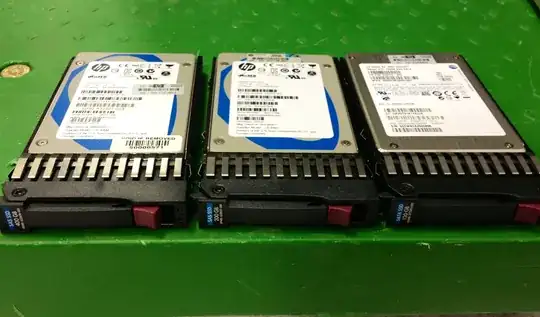Okay. This is an interesting question, as there are a number of options available to you.
Some concepts to clarify and understand, as they relate to this situation:
- Perceptions of "speed" or "fast".
- RAID controller performance.
- SAS topology.
- Benchmarking a system and/or identifying bottlenecks.
In order to get the maximum performance, we really need each logical drive to run as fast as possible.
Storage performance is not always about bandwidth!! Latency, I/O read and write patterns, queuing, application behavior, caching, etc. are all factors. Given what you've described, you're nowhere near saturating the link to your storage.
The current HP server has a fairly low-end array card
No it doesn't. The Smart Array P410i controller is the onboard controller available on the G6 and G7 ProLiant servers. It performs just fine, as long as a battery-backed (BBWC) or flash-backed (FBWC) module is installed. It's limited to the internal bays of the server and has no SAS oversubscription. There are two SAS SFF-8087 4-lane connectors linking the motherboard to the backplane, each providing 6Gbps full-duplex bandwidth.
Currently, we're looking at something like a D2600 with a high-end
Smart Array card.
The other RAID controllers in HP's portfolio for that server generation perform similarly (Smart Array P411 and P812). They differ in that they provide more flexible or external connectivity. The D2600 enclosure would potentially be a step-down in raw throughput, depending on its configuration. However, it's absolutely the wrong choice for this setup, as it only accommodates large-form-factor 3.5" disks. The D2700 enclosure is the variant that houses small-form-factor 2.5" disks.
SSMS Activity Monitor and Perfmon show that most of the time the
server is waiting for the disk
This is an issue with the single 120GB SATA SSD you're using. I have one sitting here. It's a low-end, slow-ass SSD. That's all. It maxes out at ~180 Megabytes/second sequential and is just an overall poor performer. HP should not sell it! It's relatively low-latency, compared to spinning disks, but is terrible for what you're trying to do. It's worse that you only have one drive. Four of them would be acceptable.
I would recommend either a pair of 400GB MLC HP Enterprise disks (made by Pliant/Sandisk) if you are not planning much growth beyond the 200GB you're using now. Otherwise, four disks would be better. Unfortunately, they are not cost-effective ($2800US+ each).
When I don't use the HP Enterprise SSDs and need to consider cost, I purchase the Sandforce-based OWC Mercury Extreme Pro drives and place them in HP drive carriers. Works great, inexpensive and is a much better deal for the generation of hardware you're using. Use RAID 1+0 and follow the P410 SSD configuration guidelines from HP. I spend a lot of time with SSDs...
array B (Solid State SATA, Unused Space: 1012121 MB)
logicaldrive 3 (400.0 GB, RAID 1+0, OK)
physicaldrive 1I:1:3 (port 1I:box 1:bay 3, Solid State SATA, 480.1 GB, OK)
physicaldrive 1I:1:4 (port 1I:box 1:bay 4, Solid State SATA, 480.1 GB, OK)
physicaldrive 2I:1:7 (port 2I:box 1:bay 7, Solid State SATA, 480.1 GB, OK)
physicaldrive 2I:1:8 (port 2I:box 1:bay 8, Solid State SATA, 480.1 GB, OK)
SEP (Vendor ID PMCSIERA, Model SRC 8x6G) 250 (WWID: 500143802335E8FF)
I have a few of these drives sitting here as I type...
Left to right: 400GB SAS MLC Enterprise SSD, 200GB SAS SLC Enterprise SSD, 120GB SATA MLC crap SSD

The rest of the items in your question are not an issue...
- You don't need external storage. External storage actually shares a 4-lane SAS connection (24Gbps == 4 x 6Gbps) back to the controller. The "multiple channels" you refer to are the same as "dual domain" or simply multipath SAS links. This is more of a resiliency feature rather than performance in this context. See: Using both expanders in HP D2700
- Internal disks are fine, as they each have dedicated 6Gbps links back to the P410i RAID controller.
- Your problem here is the SSD you're using. Even 4 300GB 10k RPM SAS drives will run better than the one HP SATA SSD you have now.
Further reading:
HP D2700 enclosure and SSDs. Will any SSD work?
Third-party SSD in Proliant g8?
Why are enterprise SAS disk enclosures seemingly so expensive?
